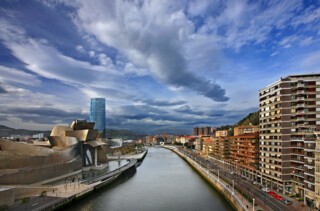Shades of Grey in Bilbao
Juan Navarro
Translated by Lorna Scott Fox
Bilbao is the only city I know where colours compete in the mind and the winners vary depending on who you ask. Older people would go for grey and black, the wide palette of shades cast by the soot and murk from factory chimneys and the ships that used to ply the River Nervión. Industry, once the driving force of the Basque economy, imposed a chromatic toll, a patina that dimmed the air and the mood. But that opaque curtain has been lifted, and for younger people (and tourists), the greyest thing around is the silver Guggenheim Museum, the focal point of Bilbao’s urban renewal. Iron and steel are still being produced, but at the turn of the century, as part of the starchitect-studded transition to a service economy, the most polluting factories were shunted up the estuary nearer the sea, and a new container port was built.
The other greyness the young hardly recall is life under the cloud of ETA, the terrorist group that tried to bomb its way to Basque independence and officially disbanded in 2018, though it had long before been defeated not only by the police and army (in what was also a dirty war by central government in the 1980s) but by popular disillusion and fatigue. The end of terror marked the end of Euskadi’s dark period. Nature’s grey remains, up there in the sky, courtesy of the low-pressure systems of the Bay of Biscay, the squalls and storms and cloudbursts without which Bilbao would be unrecognisable; the sudden downpours immediately followed by blue skies and the scent of petrichor, as if the atmosphere were apologising for causing that stampede to the shelter of the arcades.
When I arrived in Bilbao I had only one friend here, and I remember looking out from his window at the novelty of churning skies. In Castile, where I grew up, the weather is predictable, harsh and dry; the wind is merciless and the cold freezes your bones until the summer heat melts them. The winter sunlight is deceitful, enticing you to leave the house in shirtsleeves, only for the icy wind to cut right through. Bilbao wasn’t like that; it told me straight: ‘This is how it is.’
The first thing I bought was a hardy pair of rainproof boots, which everyone wears here, even on a Saturday night out. They’re also good for a spontaneous walk through the hills encircling the town: ‘Hey, it’s clearing up, let’s go!’ The urban centre fills a bowl between two small ranges, a million inhabitants packed into seven square miles, and on three sides the green escarpments glimpsed at the ends of streets look near enough to touch.
Greens and blues have replaced the greyscale. The Nervión is no longer polluted but flows clean to the sea. On the beach at La Salvaje there’s one side for nudists and another for the clothed but no demarcation. It isn’t only Bilbao’s motorway verges, playing fields and pastures that have got greener, but its municipal policies too. A tramway was opened in 2002 and extended in 2022. There are bike lanes now. Three-quarters of those aged between 15 and 29 consider themselves environmentalists, and many, particularly women, have been on environmental protests. But traditions continue, whether it’s playing pelota, competitive stone-lifting, or drinking txakolí and eating pintxos.
The cauldron-shaped valley has recently experienced temperatures that were once unusual for the north of Spain. It was over 42ºC some days last summer, when the average is supposed to be (or used to be) 25ºC. On social media, photos of the Guggenheim, the Vizcaya Bridge and the football at San Mamés were outnumbered by snaps of public thermometers. At night, a tropical temperature of 20°C or more is increasingly common.
But it was last New Year’s Eve that the anomalies really hit home. We entered 2023 in shorts and swimsuits, with 25ºC, as against the average of 14ºC. The people of Northern Spain, in Asturias, Cantabria or Euskadi, have always welcomed a certain suspicion of the region’s greenness, the common knowledge that it always rains up here: anyone looking for a suntan should stick to the Med, and leave the north to those who truly enjoy our alternating dark and bright skies. But what if even that changes?
This piece is part of the LRB’s collaboration with the World Weather Network.


Comments